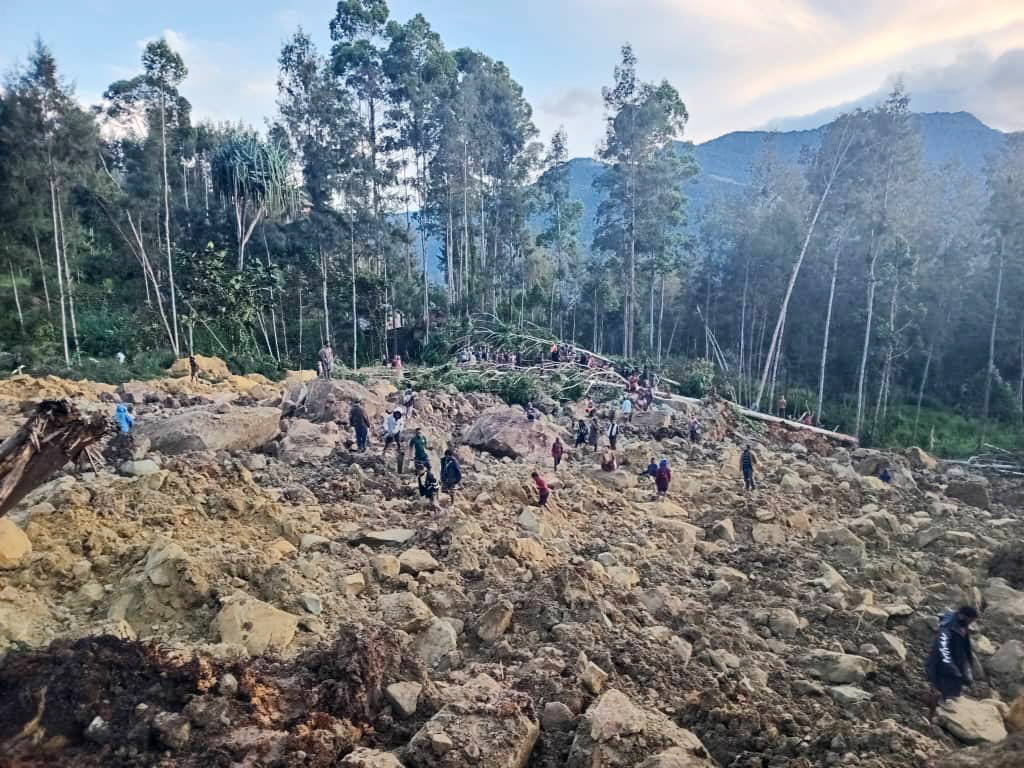Papua New Guinea landslide: A call for support

Most of the time I feel pretty connected to the world around me, and as a self-described “disaster junkie,” pretty on top of the disasters that happen. In one disaster chat I’m a part of, folks are so connected that we’re usually discussing details before they even hit social media, let alone mainstream news.
So after a four-day weekend spent disconnecting as much as possible, I was shocked to learn of a massive landslide in Papua New Guinea when I began work Tuesday morning. The visual imagery is stunning. A debris scar as big as four football fields. The main highway for Enga province is blocked off, so the already hard-to-reach community is nearly inaccessible. More landslides are imminent.
Amid what seems like an onslaught of disasters around the world, including the continuing severe weather events that have brought tornadoes, rain and flooding across the U.S., it’s easy to understand donors’ struggle to determine how best to help landslide survivors on their long road to recovery. My CDP colleagues and I invite our community of donors and grantmakers to also navigate these crises with us, leaning on our expertise and those of our local partners to help inform your disaster giving.
Navigating immense needs amid increasing disasters
The impact of the recent landslide is huge. An estimated 2,000 people are dead, though only a handful of bodies have been retrieved. Thousands more, many under 16, are affected and need to be evacuated. Many people in the country are subsistence farmers and their food and fields are buried. As is their clean water supply. Tensions are high, so conflict and violence, often already present, are increasing.
But when I checked my email, crickets. No updates from our usual NGO partners. No requests for information from clients or colleagues. No funders reaching out to offer support. And I get it. It was a long weekend, and it has been a long year. We’re exhausted.
As of May 28, we’ve already created 21 disaster profiles in 2024; three-quarters of our total for 2023. This is a significant increase from five years ago and we’re not even halfway through the year.
If a disaster affects you, your family or your community, it is an all-consuming presence in your life. But at CDP, our team of experts must use our judgment to determine how we as an organization will respond to each disaster. Which ones get a profile on our disasters page? Which CHEs are only profiled in the weekly blog post on roughly a quarterly basis (as happened to 10 of them in 2023 and nine so far in 2024)?
We know that traditionally some disasters don’t get as much attention as others. Often, it’s harder to get attention for international natural hazards than domestic ones. This year, we’ve had eight natural hazard disasters – three domestic and five international. And it’s always hard to drive attention to CHEs. They’re usually far away, long-lasting and as complex crises, don’t attract attention with the splashy photos the way a hurricane does.
We’ve had generous funders who have supported us and generous clients who have directed dollars directly to groups on the ground. Yet, our NGO partners across the world struggle to find enough funds to meet demand. Even the United Nations is falling short on humanitarian appeals.
Every day we ask ourselves:
- What do our donors, clients and partners need to know about?
- How do we choose when to fundraise for our disaster funds and when to direct funders to NGOs on the ground?
- When should we be pushing out information proactively, rather than responding to requests?
These are the hard decisions that we grapple with every day. It’s complex. Many factors go into these decisions, and we continue to refine our approach as disasters continue to affect communities worldwide at a more frequent and greater scale.
Answering the call of landslide survivors
When I look at the landslide in Papua New Guinea, I see a struggling nation rich in natural resources but exploited and facing high levels of poverty. There is a request for international assistance from the government. Australia is responding with funds, supplies, equipment and people.
The disaster happened Thursday, May 23, and statistically, unless media attention stays hyper-focused (witness Lahaina last summer), individual donations tend to dry up in the first week. But tremendous need remains.
This is where you come in. I’m asking you to dig deep. We’re five months into 2024 and I know we’re all facing disaster and donor fatigue. Hurricane season begins on Saturday, June 1, and it is predicted to be one of the biggest ever. This won’t be the last time we ask. If you can, please support our Global Recovery Fund to help communities like those in Papua New Guinea.
